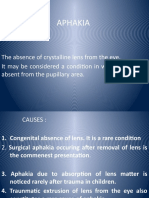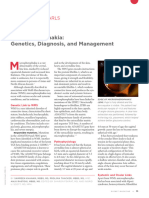0% found this document useful (0 votes)
276 views22 pagesAphakia and Pseudophakia2
The document discusses aphakia and pseudophakia, defining aphakia as the absence of the crystalline lens and pseudophakia as its correction through intraocular lens (IOL) implantation. It covers causes, optics, clinical features, and treatment options for aphakia, including spectacles, contact lenses, and IOLs, while also detailing the calculation of IOL power and management of pseudophakia. Additionally, it addresses blur retinal imagery and its treatment options.
Uploaded by
sharmasheetal7034Copyright
© © All Rights Reserved
We take content rights seriously. If you suspect this is your content, claim it here.
Available Formats
Download as PPTX, PDF, TXT or read online on Scribd
0% found this document useful (0 votes)
276 views22 pagesAphakia and Pseudophakia2
The document discusses aphakia and pseudophakia, defining aphakia as the absence of the crystalline lens and pseudophakia as its correction through intraocular lens (IOL) implantation. It covers causes, optics, clinical features, and treatment options for aphakia, including spectacles, contact lenses, and IOLs, while also detailing the calculation of IOL power and management of pseudophakia. Additionally, it addresses blur retinal imagery and its treatment options.
Uploaded by
sharmasheetal7034Copyright
© © All Rights Reserved
We take content rights seriously. If you suspect this is your content, claim it here.
Available Formats
Download as PPTX, PDF, TXT or read online on Scribd
/ 22
























































































